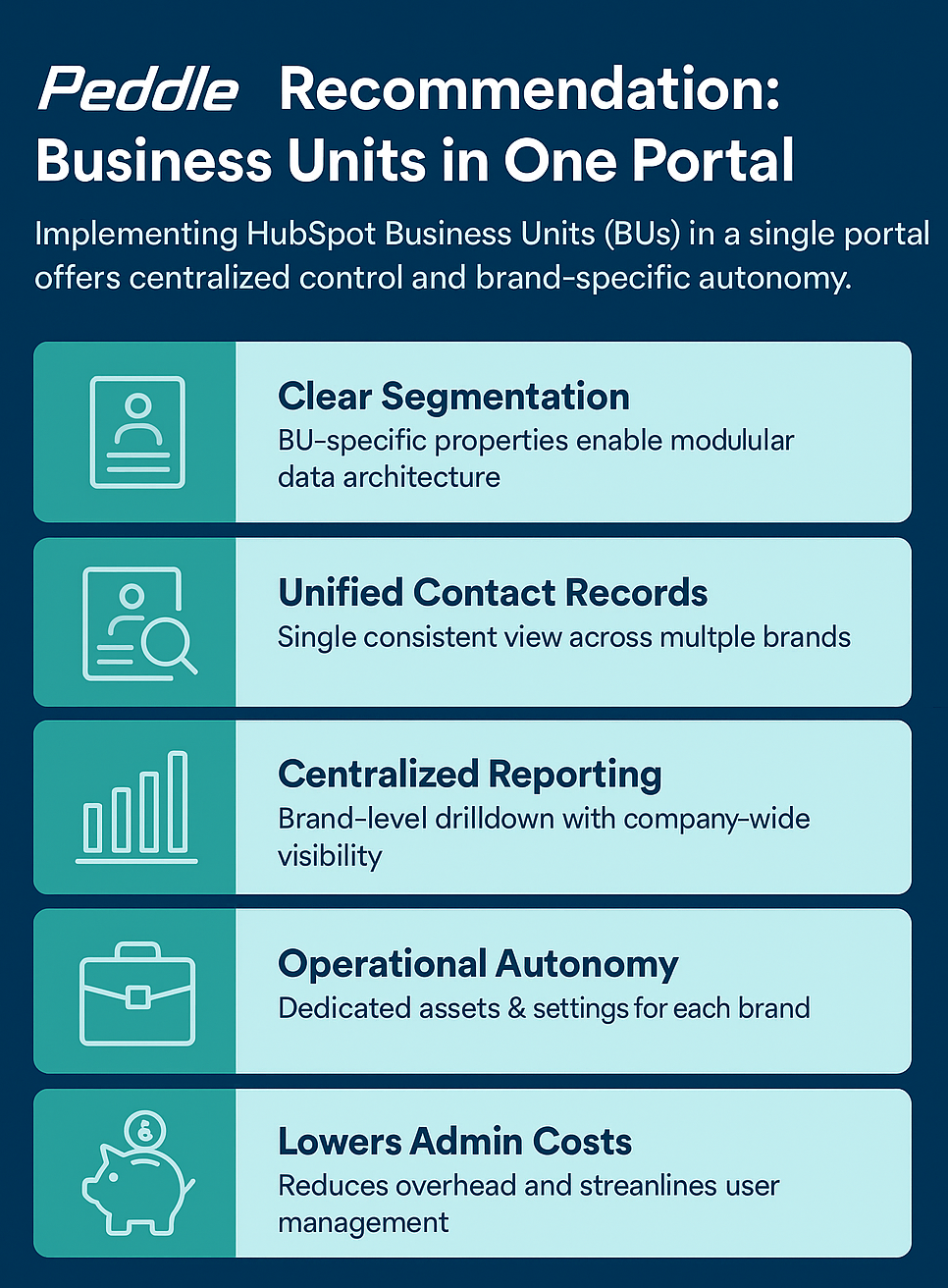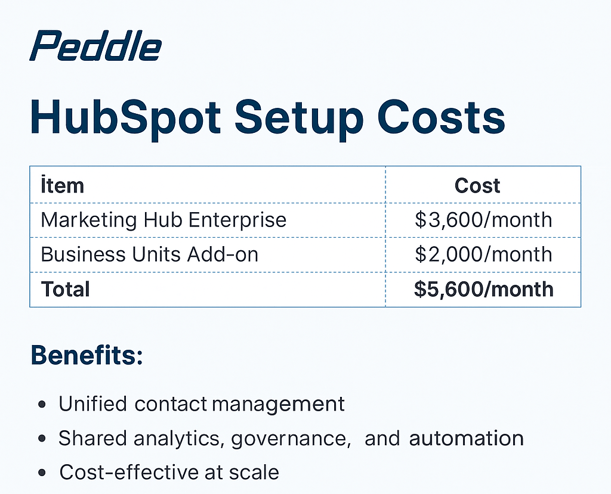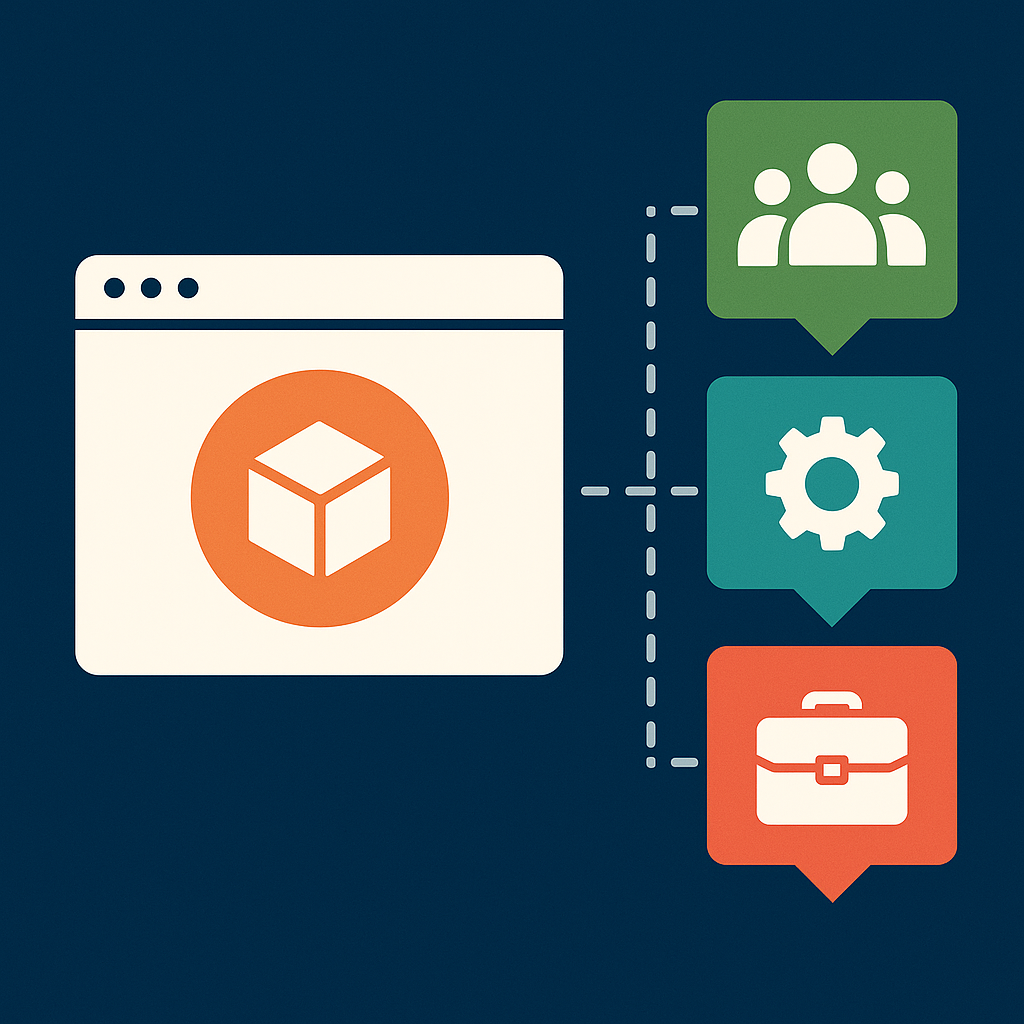When it comes to implementing HubSpot across complex businesses, architecture is everything. A misaligned setup can create data silos, poor segmentation, and operational inefficiencies that compound over time. At Peddle, we work with organizations facing these challenges head-on, delivering scalable CRM solutions that align with both current operations and future growth.
In this case study, we present a strategic comparison of three HubSpot architecture options:
-
Separate Business Units in One Portal
-
Separate Portals
-
One Portal with Manual Brand Management
Our client needed to overcome major CRM challenges stemming from stakeholder diversity, flawed segmentation, and legacy data models. We provided a comparative analysis, selected the ideal approach, and developed a robust implementation plan that supports both strategic oversight and operational efficiency.
Background and Key Context
The CRM Challenge
This engagement was driven by two interrelated initiatives:
-
Architectural Decision Task: Determine how to structure HubSpot to support multiple brands, diverse stakeholder types, and brand-specific communication flows.
-
CRM Audit Task: The client was relying on a severely overloaded “Type of Contact” field. Their CRM was cluttered with investors, operators, government contacts, and military partners-many of whom served multiple roles. This lack of clarity made effective segmentation nearly impossible.
Given this complexity, the solution needed to:
-
Promote clear and scalable segmentation
-
Reduce redundancy and duplicate records
-
Enable automated, targeted communication by stakeholder type
-
Preserve centralized oversight
Evaluating HubSpot Architecture Options
Option 1: Separate Business Units in One Portal
HubSpot's Business Units feature allows you to manage multiple brands within a single portal. Each BU can operate with its own branding, domains, subscription types, forms, workflows, and assets, while the data remains centralized.

Advantages
-
Unified Contact Records: A single contact can belong to multiple BUs without duplication.
-
BU-Specific Customization: Separate assets, properties, and workflows per BU.
-
Cleaner Segmentation: Eliminates reliance on flawed fields like "Type of Contact."
-
Centralized Oversight: Reporting and governance remain unified.
-
Operational Efficiency: Single login, simplified user and billing management.
Disadvantages
-
Partial Global Constraints: Some objects can't be customized per BU.
-
Ownership Ambiguity: Requires defined policies for shared contact ownership.
-
Permission Complexity: Needs careful configuration of teams and views.
Recommended For
-
Organizations with overlapping contacts and brands.
-
Businesses requiring brand-specific communication with centralized control.
-
Enterprises seeking both autonomy and unified reporting.
Option 2: Separate Portals
Each business unit has its own completely isolated HubSpot instance.
Advantages
-
Complete Data Isolation: Ideal where regulation or legal barriers prevent data sharing.
-
Full Customization: Pipelines, integrations, and workflows are brand-specific.
-
Operational Autonomy: No dependency between units.
Disadvantages
-
No Cross-Portal Visibility: Shared contacts must be duplicated.
-
High Maintenance: Multiple logins, syncing tools, and increased admin effort.
-
Persistent Segmentation Issues: Still reliant on flawed contact-type fields in each portal.
Recommended For
-
Legal or regulatory necessity for data separation.
-
Fully independent brand operations.
-
Organizations with high autonomy and no need for contact overlap.
Option 3: One Portal Without Business Units (Manual Management)
All brands and business functions operate in a single HubSpot portal. Brand separation is enforced manually.

Advantages
-
Cost-Effective: No Business Unit add-on needed.
-
Simplicity: One portal, single reporting view.
-
Quick Setup: Ideal for early-stage or single-brand orgs.
Disadvantages
-
Manual Segmentation: Complexity increases rapidly with scale.
-
Limited Subscription Options: Can’t offer brand-specific preferences.
-
Clutter Risk: Higher chance of errors and asset confusion.
Recommended For
-
Single-brand or low-volume businesses.
-
Small teams with straightforward CRM needs.
-
Businesses not ready for Business Units investment.
Comparative Summary Table
| Feature / Requirement | Business Units in One Portal | Separate Portals | One Portal, No BUs |
|---|---|---|---|
| Shared Contact Visibility | Yes | No | Yes |
| Resolves Segmentation Issues | Yes | No | No |
| Brand-Specific Subscription Preferences | Yes | Yes | No |
| Custom Assets and Workflows | Partially | Fully | Manual Only |
| Centralized Reporting and Oversight | Yes | No | Yes |
| Risk of Operational Missteps | Low | Low | High |
| Setup and Maintenance Complexity | Moderate | High | Low |
| Cost Efficiency | High | Low | Highest |
| Suitable for Overlapping Roles | Yes | No | No |
Peddle’s Recommendation: Business Units in One Portal
After an in-depth audit of the client's CRM environment and careful consideration of their long-term goals, Peddle recommended implementing Separate Business Units (BUs) within a single HubSpot Enterprise portal. This recommendation wasn't just based on functionality—it was rooted in strategic alignment with the client’s operational structure, segmentation challenges, and need for scalable CRM governance.
This architecture offered the perfect balance between centralized control and brand-specific autonomy, solving both current pain points and preparing the organization for future expansion.
Why This HubSpot Architecture Was the Most Strategic Choice
HubSpot offers several ways to structure your portal, but for companies juggling multiple brands, stakeholders, and communication streams, Business Units provide a purpose-built, scalable solution.

Here's why Peddle, as a HubSpot Solutions Partner, confidently advised this path:
Enables Clear Segmentation through BU-Specific Properties
One of the client’s biggest roadblocks was an overused and vague “Type of Contact” property that tried to lump investors, partners, operators, government entities, and internal stakeholders into a single dropdown. This not only confused reporting—it also limited the ability to trigger meaningful automations and nurture tracks.
With HubSpot Business Units, segmentation became intuitive and structured. Each BU could define:
-
Its own custom contact properties (e.g., Investor Tier, Operator Category)
-
Tailored forms and workflows
-
Brand-specific subscription preferences
This replaced the outdated segmentation logic with a clean, modular, and scalable data model.
SEO Boost: For organizations looking to optimize CRM segmentation in HubSpot, Business Units allow you to build intelligent, brand-aligned data architecture without code.
Maintains Unified Contact Records Across Brands
One of the core limitations of using multiple HubSpot portals is contact duplication. If a stakeholder interacts with multiple brands or functions—say, an investor who also serves as a corporate advisor—they would exist as two different records in two different systems. This fragments lifecycle visibility, ruins reporting, and increases the risk of miscommunication.
In contrast, a single Enterprise portal with BUs allows for:
-
A single contact record that can belong to multiple brands
-
Consolidated communication history
-
Unified reporting and engagement metrics
This not only preserved a single source of truth but also supported multi-touch attribution and more intelligent decision-making across the business.
Facilitates Centralized Reporting with Brand-Level Drilldown
Many growing businesses face a dilemma: they want executive-level visibility across the organization while still empowering brand teams to act independently. Business Units bridge this gap perfectly.
By using BU filters in HubSpot dashboards and reports, stakeholders gained:
-
Cross-brand performance views
-
Brand-specific campaign metrics
-
Centralized attribution reporting
Executives could now monitor enterprise-wide growth without requiring data exports or third-party BI tools, while BU leads could focus on their vertical’s performance.
This is a game-changer for HubSpot reporting across multiple brands—something not easily achievable in a multi-portal setup.
Provides Operational Autonomy for Each Brand Team
Although everything lived in one unified HubSpot instance, each BU functioned almost like its own CRM environment. Each brand had:
-
Separate domains and subdomains
-
Dedicated email templates and workflows
-
Unique forms, CTAs, and landing pages
-
Brand-specific subscription types
This meant each marketing or sales team could operate independently, using only the assets relevant to their workflows, without affecting or confusing other BUs.
With BU-specific user permissions, it was easy to ensure each team saw only what they needed—preserving focus, security, and compliance.
Reduces Long-Term Admin Overhead and TCO
While Business Units do require an upgrade to Marketing Hub Enterprise, they quickly prove their ROI by simplifying operations. Here's how:
-
No need to recreate workflows across multiple portals
-
Centralized user management and billing
-
Shared access to integrations like Salesforce or NetSuite
-
Unified governance and compliance controls
Compared to running and maintaining two or more separate HubSpot instances, the Business Units model is more sustainable, less error-prone, and easier to scale.
For companies exploring cost-effective ways to scale HubSpot for multiple brands, BUs offer the best return on investment over time.
Strategic Advantages of Business Units for HubSpot Implementation

Implementation Roadmap by Peddle
1. Define Business Units
-
BU1: Investors (Buy-side and Sell-side)
-
BU2: Customers (Operators, Government, Corporates)
-
BU3 (Optional): Internal stakeholders, partners, advisors
2. Redesign Data Model
-
Decommissioned "Type of Contact"
-
Created BU-specific segmentation fields (e.g., Investor Tier)
3. Segment and Migrate Assets
-
Reassigned forms, workflows, and pages to relevant BUs
-
Set naming/folder conventions for asset clarity
4. Set Up Permissions
-
Created Teams with brand-specific access
-
Assigned automation responsibility and data ownership
5. Phased Data Cleanup
-
Tagged contacts by BU
-
Standardized field usage
-
Retired old workflows and properties

Pricing Breakdown: Business Units vs. Separate Portals
Option 1: Business Units in One Enterprise Portal
Implementing Business Units under a single HubSpot Enterprise instance enables centralized control and brand-level autonomy—all while maintaining one unified CRM ecosystem.

This cost includes powerful features such as advanced reporting, team permissions, custom objects, field-level permissions, programmable automation, and of course, multi-brand management through Business Units.
Key Benefits of This Approach
-
Unified Contact Management: No more duplicating contacts across portals. Every stakeholder is managed through a single source of truth.
-
Shared Analytics & Governance: Cross-BU dashboards and enterprise-wide reporting allow for holistic decision-making while BU teams stay focused on their own operations.
-
Operational Efficiency: Centralized integrations, shared assets, and streamlined billing cut down overhead and reduce tool sprawl.
-
Scalable CRM Architecture: As your business grows, this model adapts. You can add more Business Units and scale automation, segmentation, and governance from a unified foundation.
Cost-Efficient at Scale: Despite the higher initial cost, the reduced duplication and overhead make this the more affordable option in the long term.

Getting HubSpot Enterprise with Business Units doesn't have to mean paying full price. Many clients Peddle supports have successfully negotiated significant reductions.
Discount Optimization Tips:
-
Bundle More Hubs: Adding Sales, CMS, or Service Hub often triggers deeper discounts.
-
Commit to Multi-Year Contracts: 2–3 year agreements typically result in significant savings.
-
Negotiate Directly with HubSpot Sales: Especially if you’re scaling fast or migrating from another system.
-
Leverage Peddle: As a HubSpot Solutions Partner, we help clients access better pricing, get startup or nonprofit verification fast, and negotiate contract terms more effectively.
Option 2: Two Separate Portals
This setup involves running two isolated HubSpot instances, each tailored to a specific brand, division, or business unit. While this might sound simpler on the surface, it comes with significant caveats.

At first glance, this seems like the cheaper option—but those savings quickly vanish due to operational duplication and complexity.
Hidden Costs and Limitations
-
Duplicated Workflows and Templates: Every automation or email campaign has to be rebuilt in each portal.
-
Manual Data Reconciliation: If contacts interact with both brands, syncing their activity and lifecycle stages becomes a massive chore—or requires third-party tools.
-
Fragmented Insights: No centralized analytics. You’ll need to export data and build cross-brand reporting in an external BI tool.
-
Multiple Logins and User Management Overhead: Admin work doubles across teams, settings, and governance.
-
Increased Integration Costs: Any third-party integration (e.g., Salesforce, NetSuite, Intercom) needs to be implemented and maintained separately in each portal.
Long-Term Risk:
As both brands grow and start requiring Enterprise-level features (e.g., advanced reporting, programmable automation, permission layers), you may end up paying Enterprise pricing twice—while still suffering from fragmented data and inconsistent operations.
Why Peddle Recommends Business Units for Scalable Growth
When managing complex stakeholder ecosystems across multiple brands, choosing the right HubSpot architecture is not optional - it's essential.
Separate Portals create silos, redundant data, and higher long-term costs. Manual Brand Management may work temporarily but will crumble under growth pressure.
Business Units in One Portal empower companies to:
-
Streamline segmentation
-
Centralize reporting
-
Eliminate contact redundancy
-
Enable operational independence across brands
Peddle's expertise in HubSpot implementation ensures not only the right architecture decision but also a seamless rollout, governance setup, and post-launch optimization.

Let’s Talk HubSpot Architecture
If your CRM feels cluttered, your segments are broken, or you're juggling multiple brands under one roof, it might be time to reassess your structure. Let Peddle help you build a HubSpot architecture that scales.
👉 Contact Peddle for a free discovery session.
Optimize smarter. Grow faster. Structure matters.

